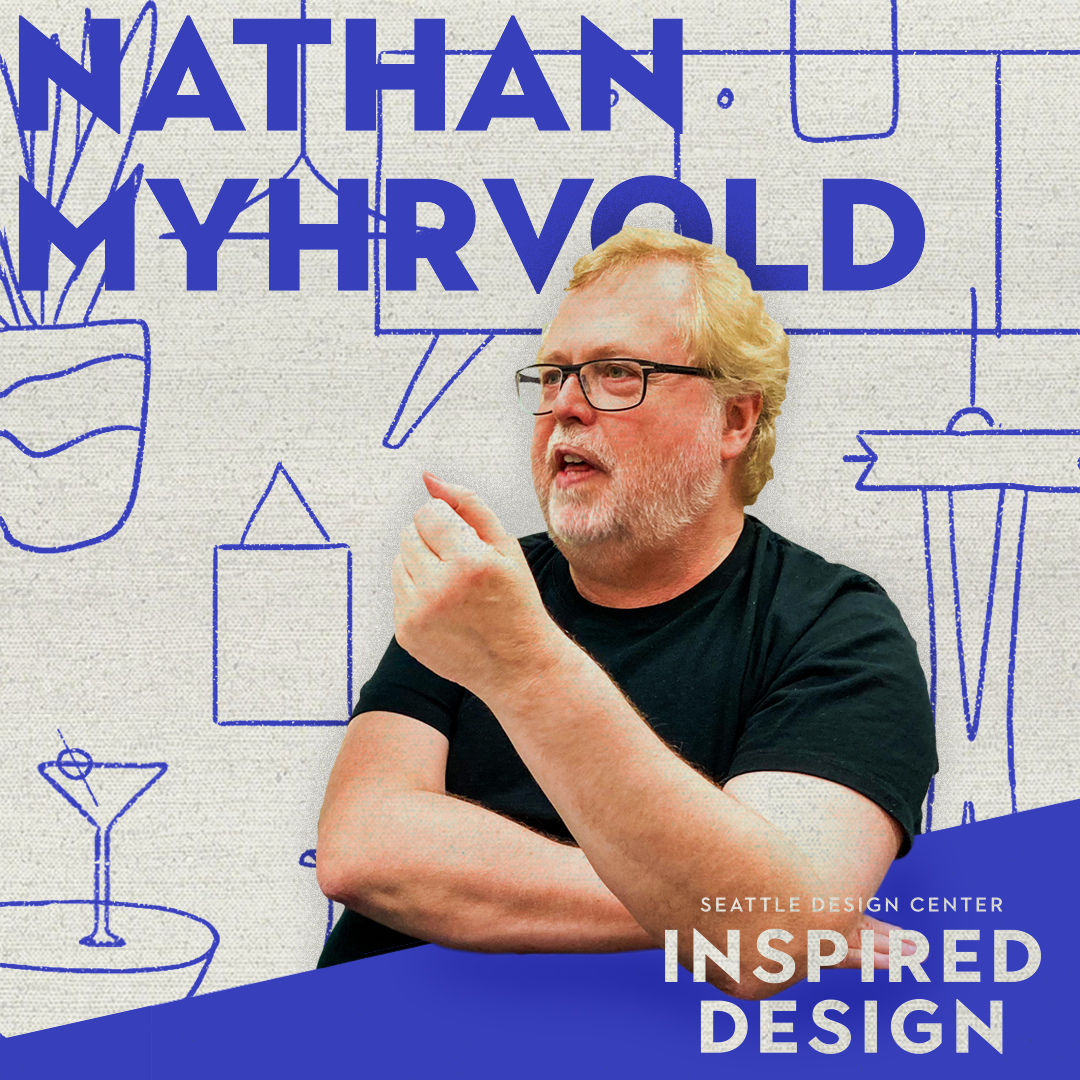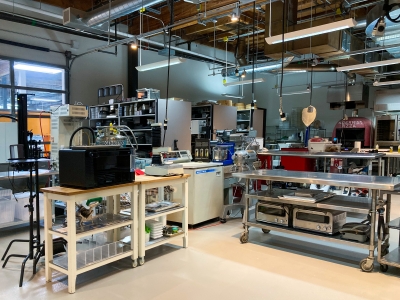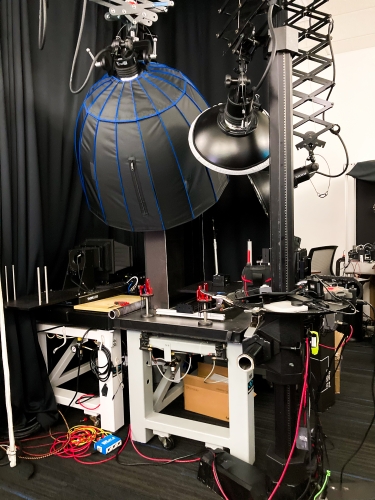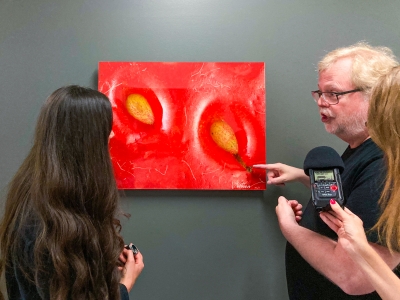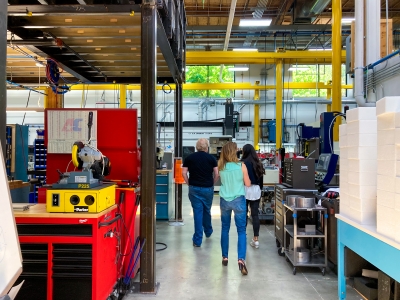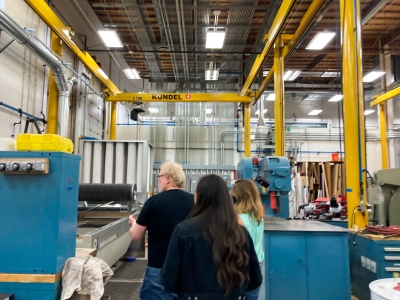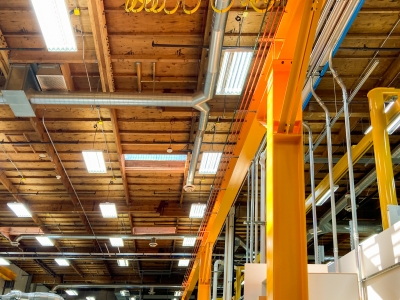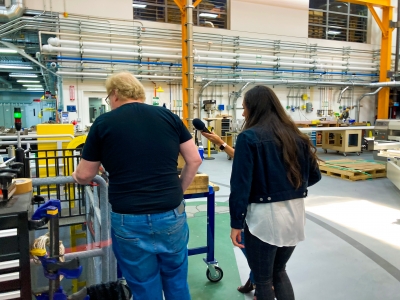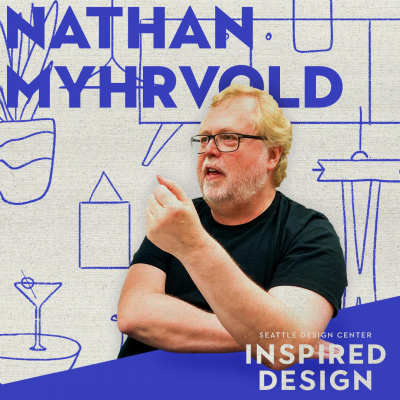
In this episode of Inspired Design, Dr. Nathan Myhrvold, a prominent scientist, technologist, inventor, author, and food photographer takes us on a tour through his Modernist Cuisine studios in Bellevue, WA. Get a glimpse into his wild world of creation and hear his hope for Seattle as we contemplate how imperfect design is a common thread through past civilizations.
Episode Transcript
Gina Colucci:
I’m Gina Colucci with the Seattle Design Center. Every week on Inspired Design, we sit down with an iconic creator in a space that inspires them. This week, I caught up with Nathan Myhrvold at his Modernist Cuisine studios in Bellevue Washington.
Nathan Myhrvold:
Here we pump water up, about 55,000 pounds per square inch. And that water can then be used to cut insanely hard metal or glass.
Gina Colucci:
Nathan is part entrepreneur, part inventor, photographer, chef, scientist, designer. But really, he is a highly educated generalist who spends his time tinkering in various disciplines, too many to count.
Nathan Myhrvold:
I am the world’s foremost expert on dinosaur vomit.
Gina Colucci:
He’s the only person I know with a PhD and a culinary degree.
Nathan Myhrvold:
Pizza is a poorly documented cuisine.
Gina Colucci:
Not to mention he spent over a decade working at Microsoft and did a post-doctoral fellowship at Cambridge under Stephen Hawking.
Nathan Myhrvold:
This is a mock-up of a nuclear reactor core.
Gina Colucci:
My conversation with Nathan was all over the map, literally. He travels to all sorts of places to optimize the best photos.
Nathan Myhrvold:
A billion cicadas will come emerging out of the ground on the East Coast once every 17 years.
Gina Colucci:
The tour of his space was like flipping through my fifth grade science book and stopping on all these different random pages.
Nathan Myhrvold:
Charles Babbage was a British genius who, in the 1840s, decided to make computers.
Gina Colucci:
I think the special thing about Nathan is that he has an ability to shift your perspective because he’s going to show you something ordinary in a way that you’ve never seen before.
Nathan Myhrvold:
So here, if-
Gina Colucci:
Can you describe what we’re looking at?
Nathan Myhrvold:
This is some pictures of blueberries, but the blueberries are bigger than a basketball here, in an actual size, in the photo. Now, if I had just taken one picture of this, the amount that’s in focus, this would have been incredibly shallow, incredibly shallow. This is about 500 photos. And so, we take 500 photos and then we use software to put them together. Well, it’s funny. They’re so big. And out of context, a lot of people don’t realize they’re blueberries. They’ll say, “What is that?” Or, this?
Gina Colucci:
Yeah. Okay. That’s the inside of a blueberry.
Nathan Myhrvold:
Yes. Did you know that blueberries had orange seeds?
Gina Colucci:
No.
Nathan Myhrvold:
I didn’t either. Or that the flesh is green.
Gina Colucci:
Yeah.
Nathan Myhrvold:
But, it is.
Gina Colucci:
I know what the inside of the blueberry looks like because my toddler smashes everywhere. So I know that. I didn’t know the seeds were orange and has, like, little cells. Like, I don’t even know what to-
Nathan Myhrvold:
Those are cells.
Gina Colucci:
Okay.
Nathan Myhrvold:
That’s individuals. You can see here and here and here, individual cells. So that’s how close up we’re getting. You can see the individual cells that make up the thing. And the thing I like about these photos is that they take a very familiar object and they show it to you in a very unfamiliar way. You can live your whole life eating blueberries without ever really looking at a blueberry because that’s not required. And if you do look at it, you’re going to look at it with human scale eyes, not with this kind of magnification. So when you do look at it, you get to rediscover it in a new way.
Gina Colucci:
As my eyes darted around Nathan’s office, because there’s just so much to look at, a bunch of stacks of papers and his computer and pens and notebooks. And then you turn and there’s just a plethora of different machines and microscopes and camera gear. And then there’s also a whole table of screwdrivers and Allen wrenches and pliers, all different sizes and shapes and colors. I spotted this skull on his desk, basically being used like a paperweight.
Gina Colucci:
I mean I have to ask, and I will, what is this skull of?
Nathan Myhrvold:
That’s a skull of a water Buffalo. Now, the reason for that, I just finished a book on pizza. The traditional cheese to put on pizza is Mozzarella Di Bufala. The Bufala part is actually an Asian water buffalo. It’s weird, but somehow water buffaloes from, like India, got to Italy, probably brought by the Romans. We actually figured a whole lot of stuff out about that for the book. So most people don’t know that this Italian thing is actually from an Asian water buffalo.
Nathan Myhrvold:
And then I had seen a chef make a flower out of mozzarella by carving the mozzarella so it looked like a white rose. So I did this homage to Georgia O’Keeffe, where we had the buffalo skull, and then some flowers made of either mozzarella or tomatoes.
Gina Colucci:
That’s amazing.
Nathan Myhrvold:
Now, strictly speaking, was that necessary for the book? Well, I don’t know.
Gina Colucci:
Yes. Yes. A hundred percent.
Nathan Myhrvold:
It was definitely fun.
Gina Colucci:
Yeah.
Nathan Myhrvold:
And it makes the point that it’s Asian water buffaloes, not cows, or not some Italian creature.
Gina Colucci:
Yeah, not an indigenous-
Nathan Myhrvold:
Nope.
Gina Colucci:
That’s amazing.
Gina Colucci:
I’m not the tiniest person. I like to say that the most creative people need some chaos. Are you in agreement with that?
Nathan Myhrvold:
Yes. I mean, I actually like it better if it was all neat. I’m just not going to take the time to do it.
Gina Colucci:
You have much better things to do.
Nathan Myhrvold:
Exactly. And as long as it doesn’t get too bad-
Gina Colucci:
No, I would say this-
Nathan Myhrvold:
Things are okay.
Gina Colucci:
Yeah.
Gina Colucci:
This way?
Nathan Myhrvold:
This way.
Nathan Myhrvold:
This is one with the crazy camera things that I built for a very specific shot, which you’ll see. So we call this The Three Amigos, and normally if you’re shooting pictures of wildlife or other things at a distance, you’ll use a very long lens. And this is the longest lens photographers typically. This is a 600 millimeter lens. During the pandemic, I was watching one of those BBC Earth things.
Gina Colucci:
With all… Yeah, with the rest of the country.
Nathan Myhrvold:
And they have these spectacular ocean waves. I want to go photograph big ocean waves during a storm. But to do that, you both need to have a long lens, but you also want a panorama. And then I also saw a bunch of bird migration things. That would be a spectacular thing to use this for.
Nathan Myhrvold:
So here we have The Three Amigos at work.
Gina Colucci:
Wow.
Gina Colucci:
So The Three Amigos camera, how do I… I mean, how do I even describe this? Picture a giant camera, multiply it by three, and then put on three giant lenses, the biggest lenses you’ve ever seen. Nathan has built this custom stand for them. And so it puts them all in a row. And the lenses of them probably extend over a foot long.
Nathan Myhrvold:
This is from a place in Missouri where enormous numbers of snow geese come during migration.
Gina Colucci:
The photo itself, printed out, is probably about five feet long?
Nathan Myhrvold:
Yeah.
Gina Colucci:
And it’s a beautiful sun rise, so you get the orange going up into yellow and then green, and you have a horizon. And then there are hundreds of thousands-
Nathan Myhrvold:
Probably. Many, many thousands.
Gina Colucci:
Many, many thousands of geese just flying throughout the entire panoramic image.
Gina Colucci:
Do you know how many snow geese are in this photo?
Nathan Myhrvold:
I have not literally counted this photo. I mean, in the refuge where we were, they were estimating 700 thousand. Now the thing that snow geese is they roost down in the water, the very shallow water at the edge. And then as soon as the sun comes up, they all take off at once. And that’s what this is about.
Gina Colucci:
How loud was that?
Nathan Myhrvold:
It was loud.
Gina Colucci:
Yeah.
Gina Colucci:
Nathan’s passion for food and photography started at a young age. By age nine, he was cooking Thanksgiving dinner for his family, and soon had a camera by his side to capture everything.
Nathan Myhrvold:
This is one that we’re getting ready to take. So this is the 4/40 tornado. We name all of the things. These are 40 millimeter lenses. So it’s four 40 millimeter lenses and cameras.
Gina Colucci:
The top case for this camera, it was kind of like an erector set on steroids. Super sleek, very industrial feel to it.
Nathan Myhrvold:
Yeah. In the previous incarnations of this, it wasn’t as compact. And it took like half an hour to set up. Anyway, on a Friday, I’m going storm chasing to photograph tornadoes. That’s why this is called the 4/40 tornado. And for a tornado, what you have to do is stop at the side of the road, jump out, take pictures. And while people are yelling, “We have to go.” And then you jump back in. So this whole thing was designed so we can do that.
Gina Colucci:
So it’s just two, really. Two pieces with the cameras.
Nathan Myhrvold:
Two pieces. That’s right.
Gina Colucci:
Wow.
Nathan Myhrvold:
Normally what storm chasing is, is hours and hours and hours of riding in a car, looking for storms. And then, moments of sheer terror.
Gina Colucci:
And what’s the hopes that you will get the largest panoramic photo of a storm ever taken?
Nathan Myhrvold:
Well, if this thing works at all, that will be true.
Gina Colucci:
Okay.
Nathan Myhrvold:
We’ll see. You don’t know whether you’re going to see a tornado or not, but even a normal thunderstorm in the Midwest is pretty damn spectacular. We never really get thunderstorms here. There, it’s really something
Gina Colucci:
So do we want to… There’s so many more things in this room.
Nathan Myhrvold:
Well, let’s keep going just to…
Nathan Myhrvold:
Okay. So now we’re going to go down into our machine shop. You get to have a peek here above it.
Gina Colucci:
So we’re looking down now and at your machine shop and it almost looks like there’s a giant yellow-
Nathan Myhrvold:
That’s a crane.
Gina Colucci:
Yep, folks. A crane. Like a three-story crane inside the machine shop.
Nathan Myhrvold:
The point of those overhead cranes is that we can move heavy things around the shop.
Nathan Myhrvold:
So here we have all manner of machine tools, which torture metal or plastic or wood in different ways. This is one I bought just this last year.
Gina Colucci:
The machine tool for the furniture had its own little home. Like, it had doors on that you would slide open. And then inside was the actual machine that printed.
Nathan Myhrvold:
I actually bought it to make furniture.
Gina Colucci:
What do you think will be your first piece of furniture?
Nathan Myhrvold:
A chair. I’ve been working on a chair. But, a cool chair.
Gina Colucci:
For a cool chair.
Nathan Myhrvold:
Yeah.
Gina Colucci:
There were so many machines, I didn’t even know where to look.
Nathan Myhrvold:
This is my Babbage engine. So Charles Babbage was a British genius, who in the 1840s, decided to make computers. But of course they didn’t have electronics in the 1840s, so he made his computer out of gears.
Gina Colucci:
Average machine has 8,000 parts, weighs five tons, and measures 11 feet long. There were all these rungs with numbers going down. It was kind of like an abacus meets a printing press, meets a machine from the 1800s.
Nathan Myhrvold:
He never finished it during his life. And people thought, oh, it was ahead of its time, and his plan will never work. Well in the nineties, the science museum in London realized they had the plans. So they decided to build one and find out could Babbage have succeeded? Well, just like Babbage’s project, they ran out of money. But then they met me. And I said, “Could you do two?”
Gina Colucci:
Why do one when you can have two?
Gina Colucci:
A little extra history on Charles Babbage. His wealthy father supported him financially so he could tinker and event all he wanted. He studied at Cambridge and then became part of London’s intellectual society, and kept company with well-known people, including Charles Darwin and Charles Dickens. While he never completed the full machine, he built a fragment of it and would show it off at as well attended society parties.
Nathan Myhrvold:
The great thing is, his plans work perfectly.
Gina Colucci:
That’s amazing.
Nathan Myhrvold:
Yeah.
Gina Colucci:
Wow.
Nathan Myhrvold:
And it’s a very complicated machine to have thought through upfront. On most machines, you think things through as much as you can upfront, and then you make a first version like, oops, I didn’t leave any place for this. But, not Babbage.
Gina Colucci:
The thing I saw next blew my mind. I wish I could describe what this looks like to you, but I’ve never seen anything like it before. It was bright blue metal and it almost looked like a giant drill the size of a VW bus.
Gina Colucci:
Now we’re underneath the giant yellow cranes.
Nathan Myhrvold:
Yeah. So this is a mock up of a nuclear reactor core that TerraPower, one of the companies I helped start, created. So that is a reactor core, or it could be.
Gina Colucci:
Could be. Wow. And you’ve got your photography going. You’re building a chair. Do you consider yourself a designer?
Nathan Myhrvold:
This is one of these things where, if other people don’t consider it, you that, should you be calling yourself that? It’s a fascinating question. Some people, if they ask me, am I an artist, it’s the same thing. Well hopefully, the things that I, the photographs that I make, or the things we do in the books, or other stuff, do have strong elements of design and aesthetics and art in them.
Gina Colucci:
How do you translate the importance and beauty of technical design?
Nathan Myhrvold:
Well, you know, the technical objects, cameras or things of that sort, have functionality on top of whatever aesthetic requirements you have of them. Now, sometimes just following the technical requirements actually produces something that’s pretty beautiful and pretty interesting in its own right. But it requires lots of creativity and different kinds of creativity, perhaps, to try to make sure that you get the functional things that have to be there done while, at the same time, achieving some other goal.
Gina Colucci:
You’ve been quoted as saying that, “Technology isn’t a barrier to emotion or creativity. It’s a great enabler.”
Nathan Myhrvold:
Well, I think… Throughout history, there are many artists who have been at the cutting edge of technology development. Leonardo DaVinci being a great example. You could argue he was an engineer. You could argue he was a chemist. You could argue he was lots of things. He was also a great artist. And photography is the recent example of that, right? So photography was a brand new thing in the middle of the 19th century and it allowed us to create a new art form, or a new means to art. And I think great photographs can be art as profound as any sculpture or painting. But if it wasn’t for the technical invention of it, you wouldn’t have it at all.
Nathan Myhrvold:
Well, more recently, we’ve had the technical development enable new things, like enable pictures of the stars. Or in the case of these camera outfits that I build, enable a slightly new kind of photo. And I think that that is an enabler of creativity.
Gina Colucci:
You’ve basically wrote the book on following your passions and designing your life. How did you do that? Do you have like a moment that you were like, “I’m going to fully embrace who I am”?
Nathan Myhrvold:
Well, so one of the problems with being me is that, in general, the world rewards specialization. The further you advanced your education, generally, the easier it is for you to carve out a unique place for you in the world, the more you get paid, the more you get rewarded. Lots of companies are run by people who’ve worked for the company for 25 years, and a combination of talent and surviving attrition and experiences brought them up to this key place. And none of that’s very attractive to me because I’ve always been interested in so many things.
Nathan Myhrvold:
I have friends in each of my different pursuits that can’t quite figure out why I waste so much time on the other ones. My physicist friend, I have a PhD in physics, and my physicist friends all will wonder and chortle just out of hearing, or sometimes just in it, in hearing, what a shame it is that I never had a career in physics. I’m like the guy gone bad to them. And the photographers will say, why aren’t you going to be at the other migration next month? And why aren’t you going to be at this. And why aren’t you going to be at that? Well, the answer is because I’m going to shoot storms, or whatever the answer turns out to be. I’m making pizza. But I like doing all of it.
Gina Colucci:
Yeah.
Nathan Myhrvold:
And I’m not sure I really have a choice in that. I just…
Gina Colucci:
I think what’s nice about this part of the conversation. It kind of humanizes this larger than life figure. I had a million other questions for Nathan and not enough time to ask them all, but I couldn’t leave without asking about dinosaurs.
Gina Colucci:
So you have a replica of a T-Rex in your living room.
Nathan Myhrvold:
I do.
Gina Colucci:
And then you found a T-Rex after that.
Nathan Myhrvold:
Yes.
Gina Colucci:
Can you tell us a little bit-
Nathan Myhrvold:
Yes. It’s like having a picture of somebody else’s kids up in your house. Yep, that’s a T-Rex, but it’s not my T-Rex.
Gina Colucci:
How tall are these ceilings?
Nathan Myhrvold:
Oh, they’re real tall.
Gina Colucci:
Yeah.
Nathan Myhrvold:
Well, the dinosaur in the mount is maybe 18 feet tall, at its tallest point. So the ceiling is taller than that.
Nathan Myhrvold:
So everyone who studies dinosaurs seriously loved dinosaurs as a kid. Now that’s not true for most professions. Most people have a job that they didn’t realize existed when they were a child. But not people in dinosaurs. So everyone who studies dinosaurs loved dinosaurs as a kid, a hundred percent of us. And basically I was working at Microsoft and I had some dealings for Microsoft with Steven Spielberg, and he invited me to the set of Jurassic Park. That sounds cool.
Gina Colucci:
Yeah.
Nathan Myhrvold:
So I went down to visit and they had a paleontologist there as the consultant for the thing, named Jack Horner. Well, Jack and I immediately hit it off. And soon after that, I started doing serious research on dinosaurs. And so, I’ve published many papers on dinosaurs. I’m working on at least two different dinosaur papers right now with various colleagues from around the world. And so, I am the world’s foremost expert on dinosaur vomit.
Gina Colucci:
That’s something not everybody can say.
Nathan Myhrvold:
The trick is getting all the way to the end of the sentence without laughing. That is the trick. It’s tough.
Gina Colucci:
You nailed it.
Nathan Myhrvold:
But it’s true. I wrote a whole scientific paper on dinosaur vomit. It turns out… Well, now here’s the better thing. There’s almost no examples, and that’s the mystery. So owls will eat rodents and birds, and afterwards they cough up something called an owl pellet. Well, it turns out, across the animal kingdom, huge numbers of birds do this, not just owls. Owls are the most famous example. But most insect eating birds do the same thing with the insect, parts of the insect. Like the outside of a beetle, the exoskeleton is too difficult for them to digest.
Nathan Myhrvold:
So anyway, the dinosaurs almost certainly did this. But it’s been very difficult to find an example of that. And that’s sort of what my paper is about.
Gina Colucci:
So you found an example.
Nathan Myhrvold:
There’s a few… I haven’t personally found one, but I’ve identified some that the other people have found. I also have done big size of dinosaur growth rates and dinosaur biomechanics. I showed that there was a set of large dinosaurs called sauropods, which had huge long whip like tails. They also had huge long necks and little itty-bitty heads. So Brontosaurus, now called apatosaurus, is an example. Well, people never figured out what the tails were for. And I proved that the tails were actually used like a bullwhip. Now, a bullwhip makes a huge noise and it does so for a very counter-intuitive reason. It actually breaks the sound barrier. So the noise you’ll hear from a bullwhip going crack is actually a sonic boom. Well, I figured out that in fact, these dinosaur tails were perfectly proportioned to make sonic booms.
Gina Colucci:
So, is that how they communicated?
Nathan Myhrvold:
It’s very likely how they communicated. In particular, there’s a place on a bullwhip which is what wears out first if you’re using your bull bullwhip all the time. And it’s in a weird spot. It’s about a third of the way down the bull whip, and it’s because that area gets a lot of stress. Well, about half of the specimens of these dinosaurs have a bone abnormality at that spot. And it’s a bone abnormality very similar to what humans get when we overuse muscles or joints. So half of the specimens were cracking their tails, almost till their tails fell off, which seems like male behavior to me.
Gina Colucci:
[inaudible 00:25:58]
Nathan Myhrvold:
Well, most weird things in biology is you’re not to be sexual selection. Antlers, for example, on deer. I think that they cracked their tails to get a date and the noise, which would travel for… If you’re an enormous animal, you eat a lot. So you can’t be really close to your own kind all the time because you run out of food. So you have to communicate for a long distance. People have found that elephants can communicate across 40 miles, for example, for this reason. So I think this is how they got a date.
Gina Colucci:
Dinosaur bones, nuclear reactor, cores, pizza ovens, tornadoes, geese migration, Nathan finds inspiration in all of these things. How? What is his through line?
Nathan Myhrvold:
One thing I love about the natural world are the cool aspects of that, that you can see that in the skeletons of the dinosaurs or, I’ve got some other creatures, too. You could also see it in some of the crazy manmade items that we’ve made. I have a big collection of radio tubes which, before transistors and solid state stuff, that was the big thing. And I’ve got a collection of old computers, which was how we’d do that I’ve got a couple engine blocks in my living room.
Gina Colucci:
And the first computer downstairs.
Nathan Myhrvold:
Well, I have, yes, that downstairs. And those are all inspiring in different ways. The human created things, particularly those that are created for a very specific mission often can be beautiful and can be very interesting objects in their own right. Meanwhile, the natural world is full all of these other incredibly beautiful and incredibly awesome things. And sort of the third aspects of that are moments, which you can’t capture except via photography. And so, photography is the other.
Nathan Myhrvold:
So I like to say, though, that in my house, I don’t have any deliberately human created art. I have my own pictures, which I’ll consider either not human created or not art. But I have mechanical devices, but those weren’t created to be art, but I think they kind of are. And then I have the natural things. And I think that, well, we live in a very technological society, and one aspect of that technology society is we tend to get rid of things that are old. But sometimes that old technology is kind of beautiful in its own right. Almost even more, if it’s what’s passed you by, and it’s not the original great, wonderful thing.
Nathan Myhrvold:
So the other thing is, people… I’m not one who’s ever going to hide his TV in something where you press a button and it comes out or some other thing. It’s like, no. I’m proud of that there’s a TV there. And there’s an old microwave tube sitting right next to it for how they used to transmit it. And, and, and, and… I think that, well, just as steam punk looks to a certain era, I’m trying to anticipate what the steam punk of 50 years from now will be, because it’s kind of how I live. When all my stuff is antique and weird.
Gina Colucci:
Well, I guess that’s the perfect segue to my last question. You’ve studied a lot of past civilizations. Has that made you kind of contemplate what future civilizations will think of us?
Nathan Myhrvold:
Oh, sure. I mean, I love visiting ruins around the world. And it’s actually something I tell some of my designer friends who are very exacting about making sure every detail is correct. I say, you know, I don’t know. I was in the pyramids, and the detail, a lot of the details are all screwed up. It’s still pretty God damned awesome. You don’t actually need every detail to still be awesome.
Nathan Myhrvold:
But we’re living at probably the fastest rate of change, any point in our history. We still have lots of ways to go. We still have tons of things that we have to accomplish both from a social agenda and from a human agenda, with respect to advances in medicine. So I’m hoping a whole lot of the things that we currently do become obsolete. Another thing I have at home is a Civil War surgeon’s kit, which is this whole… It’s like a tool kit, but of all of these things they would use, and a lot of them are pretty horrific because that was like, “Oh, you got a scratch? Well, best we better take the arm off of the elbow.” I’m exaggerating a little bit, but the state of the art medicine of that era is horrific to us. And I’m sure hoping that medicine today seems horrific at some point.
Nathan Myhrvold:
Yet at the same time, we’ve been in a period of relatively, well, informed continuity, I’ll say. It’s not the same as the Renaissance. But from the Renaissance to us, there was no dark ages where everything was lost. We have all of the writings, or almost all the writing and almost all of the stuff there. You can go to Florence and see all of it, and it’s still awesome, and it’s still made for us, effectively. So although politically, we’ve advanced and technology has advanced since the Renaissance, we’ve enormous continuity. It’s probably a longer period of continuity than most times in human history. And so I’m hoping that what we do is we continue like that. That Seattle circa 2021 seems as quaint as Florence circa 1500 does to us today, but not because we went through some enormous catastrophe, but rather because we managed to keep it together while society in the world evolved.
Gina Colucci:
Nathan’s space is full of quirky items. What’s the most unexpected thing you have in your home? Head to Seattle Design Center’s Instagram post for this episode and tell us what it is.
Gina Colucci:
Inspired Design is brought to you by the Seattle Design Center. The show is produced by Larj Media. You can find them at L-A-R-J, media, dot, com. Special thanks to Miji Suzuki, Lisa Willis, and Kimmy Design for bringing this podcast to life. For more, head to seattledesigncenter.com, where you can subscribe to our newsletter and follow us on social media. If you’re looking for inspiration, come check out the Seattle Design Center in Georgetown. We’re open Monday through Friday, nine to five.
Gina Colucci:
On the next episode of Inspired Design, Denise and Miye Moriguchi give us a tour of the recently remodeled Uwajimaya flagship store in the heart of Seattle’s international district.
Denise Moriguchi:
I would say our [foreign language 00:34:27] and our grandmother would probably be just astounded at what the kitchen and the deli looks like today. We remember her in the old store. She would make lunch for all of the employees every day, and she would hand roll the sushi rolls and curries, and all of the different dishes.


